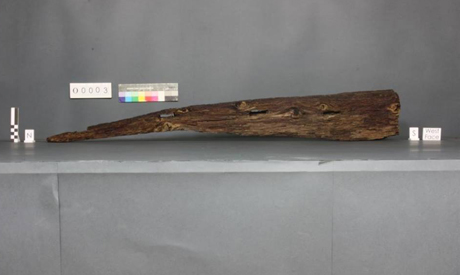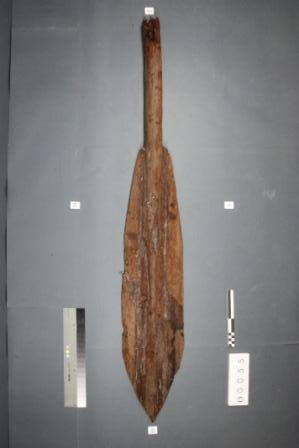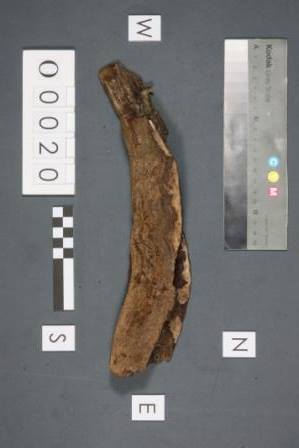
Nevine El-Aref , Wednesday 12 Nov 2014

wooden beam of khufu's second solar boat Today, fifteen wooden beams of King Khufu's second solar boat were transferred to the store of the Grand Egyptian Museum (GEM) after restoration.
The beams were restored in situ at the Giza plateau after being removed it from a pit neighbouring the Great Pyramid of Khufu. They had suffered damage from fungi and insects, Afifi Rohayem, head of the Khufu Solar Boat Restoration Project, told Ahram Online.
Rohayem continued that when all the beams are restored the whole boat will be reconstructed in order to be ready to be placed on display beside the first boat (which is currently on display in a museum especially constructed for it on the plateau) at the GEM when it opens.

wooden paddle (identified as wooden beam in original article)
Rohayem explained that the restored beams were in a critical condition, which is why they had been selected from 200 others found in the first layer of 13 layers that comprise all the boat's beams.
"This is the third phase of a five-stage project to restore Khufu's second boat," said Rohayem adding that the first phase began 20 years ago, when in 1992 a Japanese scientific and archaeological team from Waseda University in collaboration with the Japanese government offered a grant of $10 million to remove the boat from its original pit, restore and reassemble it and put it on show to the public.
The team cleaned the pit of insects but found that water had leaked from the nearby museum that houses the first solar boat. This leakage had affected a small part of the wood, hence the necessity to quickly undertake restoration work. The Japanese team, under the direction of Professor Sakuji Yoshimura, inserted a camera through a hole in the chamber's limestone ceiling to transmit video images of the boat onto a small TV monitor on site. Images screened showed layers of wooden beams and timbers of cedar and acacia, as well as ropes, mats and remains of limestone blocks and small pieces of white plaster. The camera allowed an assessment of the boat's condition and the possibility of restoration.
Yoshimura told Ahram Online that during the Egyptian Japanese team inspection they found that the second boat was in a much better state of preservation than the first when it was discovered in 1954 by architect and archaeologist Kamal El-Malakh, together with Zaki Nour, during routine cleaning on the south side of the Great Pyramid.
The first boat was removed piece by piece under the supervision of master restorer Ahmed Youssef, who spent more than 20 years restoring and reassembling the boat. The second boat remained sealed in its pit until 1987, when it was examined by the American National Geographic Society by remote camera. After the space inside the pit was photographed and air measurements taken, the pit was resealed.
It was thought that the pit had been so well sealed that the air inside would be as it had been since ancient Egyptian times, Yoshimura pointed out that sadly this was not the case. Air had leaked into the pit from outside and mixed with the air inside. This had allowed insects to thrive and negatively affect some wooden beams.

Source: Al Ahram
© 2004-2026 Bill McNulty All Rights Reserved